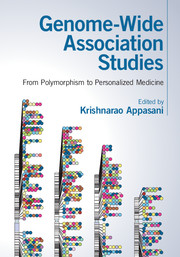Book contents
- Frontmatter
- Dedication
- Contents
- List of contributors
- Forewords
- Preface
- List of abbreviations
- Part I Genome-wide association studies
- Part II Genome-wide studies in disease biology
- Part III Single nucleotide polymorphisms, copy number variants, haplotypes and eQTLs
- Part IV Next-generation sequencing technology and pharmaco-genomics
- 15 Next-generation sequencing for rare diseases
- 16 Next-generation sequencing for complex disorders
- 17 Chromosomal breakpoints in breast cancer co-localize with differentially methylated regions
- 18 Signaling network analysis of genomic alterations predicts breast cancer drug targets
- 19 Pharmacogenetic studies in pediatric acute myeloid leukemia
- 20 Pharmaco-genomics of antiretroviral drugs
- Part V Population genetics and personalized medicine
- Index
- Plate section
- References
15 - Next-generation sequencing for rare diseases
from Part IV - Next-generation sequencing technology and pharmaco-genomics
Published online by Cambridge University Press: 18 December 2015
- Frontmatter
- Dedication
- Contents
- List of contributors
- Forewords
- Preface
- List of abbreviations
- Part I Genome-wide association studies
- Part II Genome-wide studies in disease biology
- Part III Single nucleotide polymorphisms, copy number variants, haplotypes and eQTLs
- Part IV Next-generation sequencing technology and pharmaco-genomics
- 15 Next-generation sequencing for rare diseases
- 16 Next-generation sequencing for complex disorders
- 17 Chromosomal breakpoints in breast cancer co-localize with differentially methylated regions
- 18 Signaling network analysis of genomic alterations predicts breast cancer drug targets
- 19 Pharmacogenetic studies in pediatric acute myeloid leukemia
- 20 Pharmaco-genomics of antiretroviral drugs
- Part V Population genetics and personalized medicine
- Index
- Plate section
- References
Summary
Introduction
Most rare diseases have a genetic base, and are inherited in a Mendelian fashion. They are usually monogenic disorders segregating in families, or are sporadic, being autosomal or sex-linked and dominant or recessive. Before the advent of the new next-generation sequencing (NGS) technologies, positional cloning was the most commonly used technique for the analysis of the genetic basis of Mendelian diseases. Usually the first step of such studies was linkage analysis in pedigrees with multiples cases. In 1986, the genes underlying chronic granulomatous disease, Duchenne muscular dystrophy, and retinoblastoma were mapped using the linkage approach assisted by the identification of patients with structural changes or cytogenetically detectable deletions (Collins, 1995). Three years later, cystic fibrosis represented the first case where the gene of a Mendelian disease was mapped based only on linkage analysis and positional cloning (Kerem et al., 1989; Riordan et al., 1989). Another classical example is Huntington's disease, although in this case the gene was identified 10 years after the disease was mapped in 1983 (Gusella et al., 1983; Huntington et al., 1993). Cystic fibrosis and Huntington's disease are examples that fulfilled the most important requisites for successful linkage studies: a set of families with the disease segregating and minimal ambiguity of the cohort member status. On the other hand, misdiagnosis, incomplete penetrances, or allelic heterogeneity have often hindered linkage studies (Botstein and Risch, 2003). Very rare diseases, with the availability of only a few affected individuals from different pedigrees, have also remained unapproachable following this methodology. Another extensively used tool for recessive diseases is homozygosity mapping (Lander and Botstein, 1987), which is based on the location of the disease gene in tracks of homozygosity in the affected consanguineous children. These regions are expected to be homozygous across all the patients, and not in the unaffected relatives. Linkage and homozygosity mapping have benefitted from the increasing densities of genetic and physical mapping, improving their power with the availability of more complete human genetic variation maps. Paradoxically, the discovery rate of new genes related to Mendelian diseases did not increase after the release of the human genome sequence, and genetic research efforts shifted preferentially to the genetics of complex disorders (Antonarakis and Beckmann, 2006).
- Type
- Chapter
- Information
- Genome-Wide Association StudiesFrom Polymorphism to Personalized Medicine, pp. 231 - 242Publisher: Cambridge University PressPrint publication year: 2016
References
- 1
- Cited by



